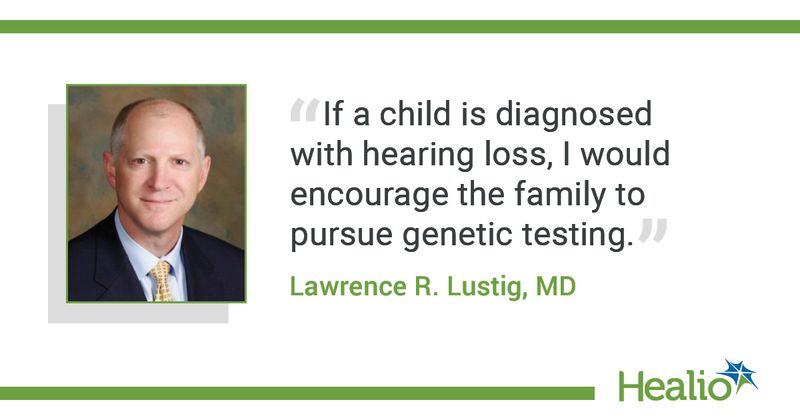Q&A: ‘Astounding’ success for gene therapy in otoferlin-related deafness
Key takeaways:
- The investigational gene therapy DB-OTO improved hearing to normal levels in two children with congenital deafness.
- Researchers plan to follow the participants for the next 5 years.
A gene therapy for otoferlin-related deafness was able to improve the hearing in two children, according to results from an ongoing early-stage trial reported at the American Society of Cell and Gene Therapy Meeting.
Regeneron initially reported in early May that its investigational gene therapy DB-OTO had improved hearing to normal levels in one child within 6 months and demonstrated improved hearing in another child after 6 weeks. Both children were born with profound genetic deafness due to variants of the otoferlin gene. The first child was dosed at age 11 months and the second at age 4 years.

Healio spoke with Lawrence R. Lustig, MD, chair of Columbia University Medical Center’s department of otolaryngology – head and neck surgery, and a clinical investigator in the Regeneron trials, about the therapy’s early success.
Healio: Why try gene therapy for otoferlin-related deafness?
Lustig: The current standard of care for congenital hearing loss is cochlear implants, which work to amplify sound to improve hearing, but these devices do not currently restore the full spectrum of sound. Imagine seeing the world in only eight or 16 colors; although it may be better than black and white, it’s still not in full color. There’s now a very robust research effort focused on otoferlin-related deafness, with several industry and research organizations investigating various gene therapies. The results to date are showing children reaching up to normal levels of hearing with supportive safety results. If a child is diagnosed with hearing loss, I would encourage the family to pursue genetic testing and evaluate if clinical trials could be an option.
Healio: Could you take us through the procedure?
Lustig: The surgical procedure leverages the same approach used for cochlear implants. We drill one hole into the ear to create a small opening, where we slowly pump the gene therapy throughout the ear, flushing the entire ear cavity with fluid that mirrors what’s typically in the cochlea, plus the gene therapy. We also make a second hole for the fluid to exit, ensuring there’s no pressure being built up in the system.
Healio: Did it perform as expected?
Lustig: The results have been astounding. The most recent CHORD trial data that we presented showed the first patient reaching normal levels of hearing at 24 weeks, and collectively as a field, there are close to 20 children with otoferlin-related hearing loss that have seen a wide range of hearing improvements, but some children also achieve near-normal hearing threshold levels.
Healio: Is there any reason to expect the improvement in the participants’ hearing won’t last?
Lustig: This is a key question for all gene therapy trials. In other diseases, there is a concern that the gene therapy that’s administered gets diluted out as the cells continue to divide as the patient matures. However, these hair cells do not fall into that case, and in preclinical models, the hearing improvements remained stable, so we are hopeful that the benefits seen continue to last. Of course, there are many unknowns, so we’re continuing to follow these patients and will share longer term results in upcoming scientific forums.
Healio: What else would you like pediatricians to know?
Lustig: As included in our ClinicalTrials.gov listing, we plan to follow these patients for 5 years because we believe it’s of the utmost importance to monitor their progress over the long term.
One key aspect that we do want to raise attention to is the awareness of genetic testing. A part of the challenge is that once a young child is diagnosed with hearing loss, there is often a quick track to schedule cochlear implant surgery. Having this procedure done bilaterally (to both ears) makes that child ineligible for our trial and others, so we do want to get the word out there to consider genetic testing to determine if there are other options available. In the United States, we have the Amplify program that provides no-cost testing for eligible patients.
The opportunity of providing the full complexity and spectrum of sound in children born with profound genetic deafness is a phenomenon I did not expect to see in my lifetime. It’s been thrilling to make a difference in the lives of not just one but many children, and these efforts are propelling gene therapy and auditory research forward to help even more.
References:
Latest DB-OTO results show dramatically improved hearing to normal levels in a child with profound genetic deafness within 24 weeks and initial hearing improvements in a second child at weeks. https://investor.regeneron.com/news-releases/news-release-details/latest-db-oto-results-show-dramatically-improved-hearing-normal. Published May 8, 2024. Accessed May 24, 2024.
